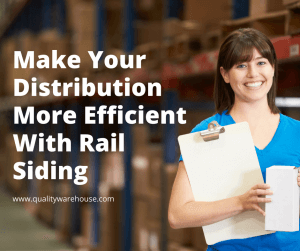Make Your Distribution More Efficient With Rail Siding
Posted on June 19, 2017 When looking into third-party logistics providers or warehousing for your business, there are certain aspects that may not jump out as important or even obvious choices. In particular, a warehouse with rail siding can be a crucial advantage for any business that plans on using railroad transportation on a consistent or sporadic basis. So not only will you get a warehouse for all of your business needs, but you also get a method of transportation that could make all orders much more efficient and distribution that much faster for customers.
When looking into third-party logistics providers or warehousing for your business, there are certain aspects that may not jump out as important or even obvious choices. In particular, a warehouse with rail siding can be a crucial advantage for any business that plans on using railroad transportation on a consistent or sporadic basis. So not only will you get a warehouse for all of your business needs, but you also get a method of transportation that could make all orders much more efficient and distribution that much faster for customers.
The way in which a business transports their goods is vital to their effective operations. Railways are a fantastic option because they provide high-volume capacity with a low cost. When transportation can be brought directly to the warehouse, it cuts out excessive and additional costs usually acquired through the utilization of trucks to transport goods.
When a warehouse possesses rail siding, it makes accessibility and proximity to the warehouse that much easier, removing the need for any additional transportation. So not only does rail siding make distribution that much simpler, but it also affects the bottom line regarding transportation costs.
What is rail siding?
Rail siding is explained as, “a section of track that is separate from the main line or through route.” These sections are characteristically low-speed sections, which mean they aren’t made for heavy traffic and high speeds. It also means that these freights won’t travel on main lines, but through smaller lines, lending to the likelihood that freights would run into far fewer delays.
Why rail over truck?
So you might be thinking: Why choose a rail over a truck? There are several reasons why freight might be a better option for your business. One is the sheer capacity that freight has for cargo over a truck. Trucks may be able to travel more places with fewer restrictions, but freight can hold more than three times that of a truck. Prices may seem much higher at first glance, but the savings made through choosing freight over trucks can be significant. As mentioned previously, railways can move much more, and fuel consumption is far less. Additionally, moving cargo on one rail boxcar as opposed to numerous trucks, it is much easier to track as one shipment.
Other benefits to choosing railways are that bad weather is not likely to affect the schedule of delivery. When roads close from storms or other weather hazards, this postpones any type of schedule or delivery with trucks. But railways are typically unfazed by the issues of the roads and are much less likely to get delayed due to accidents or traffic. There are pros and cons to each system, but railways lend themselves to further convenience and exemplary efficiency.
Eco-friendly
Furthermore, if you are trying to keep your company eco-friendly, using railways is one way to reduce your carbon footprint. When merchandise is moved through railways, it creates less environmental impact than those transported through trucks. The fuel efficiency is much greater on rail siding than it is for trucks, leading to fuel reduction and related carbon emissions.
It’s important to remember that not all warehouses possess situations where railways are available. If you want your warehouse to be rail accessible, you may need to do some research on which third-party logistics providers offer this kind of transportation for your goods. Partnerships with railways could also be a good plan as they will be able to meet the long haul transportation needs of customers across numerous geographical areas.




